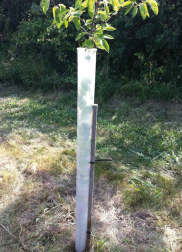How to protect your seedlings from deer browsing:
The Kalamazoo Conservation District is dedicated to providing high-quality seedlings and sharing effective practices to ensure their survival. Recently, staff attended a training focused on safeguarding seedlings from deer browsing. Historically, we have provided 2-3 foot tree tubes and deer repellents to enhance seedling survival rates. However, after careful consideration, we have decided not to sell any tree tubes this year for two primary reasons.
Firstly, shorter tree tubes have proven to be an unreliable means of protecting seedlings from deer browsing. Although these shorter tubes aren't ideal for deer browsing,
they can be effective to protect your seedlings from pets, rabbits, mowers, etc. Secondly, taller tree tubes are readily available online and can be purchased directly at a lower cost than if
acquired through our ordering process. For your convenience, resources for alternative options are provided below.
Tree Tubes in the Midwest:
Tree tubes, also known as tree shelters, serve as a valuable tool for shielding seedlings from white-tailed deer and herbivores, creating an optimal growing environment. These translucent shelters reduce deer browse while allowing sunlight penetration, minimizing wind stress, and providing protection against sudden temperature changes.
In the Midwest, tree tubes on deciduous or coniferous trees should ideally be at least 5 feet tall, aligning with the typical "browse line" height of white-tailed deer.
Although some professionals have utilized 4-feet tall tubes with success, it's crucial to recognize that these fall below the browse line. This exposes seedlings' terminal buds to deer once they
surpass the 4-feet tube, making survival dependent on local deer densities and feeding behavior. To ensure a safer approach, 5-feet tall tree tubes are recommended. This approach allows trees to grow
within the tube until surpassing it, significantly reducing the risk of over-browsing damage to terminal buds.
For shrubs, an ideal tube, wider in diameter than those for trees, promotes shrub-like growth instead of a single trunk. Recommended at 5 feet tall, shrub tubes may
acceptably be 4 feet, given shrubs' ability to withstand some browsing pressure with multiple leaders. Ventilation is key, with rigid tubes featuring small holes suitable for deciduous and certain
coniferous trees. Mesh-style tubes are recommended for specific coniferous trees and deciduous or coniferous shrubs, facilitating lateral branch and basal sprout growth.
Alternative Protective Measures:
We continue to offer Deer Out repellent for deer browsing control.
Fencing emerges as a successful tactic for deer exclusion, offering numerous options based on deer density, cost, and aesthetic preferences. An 8-feet high fence, positioned close to ground level, is generally sufficient, as deer are unlikely to take risks when alternative food sources are available. This method provides effective protection by limiting the impact of deer on seedlings.
Another option is the use of bud caps, especially common for coniferous trees. These caps involve stapling small pieces of paper around terminal buds, protecting them
from snow and other elements. While a 4” x 6” paper is generally suitable, trees with weak terminal shoots, such as young white pine, may benefit from smaller pieces (3” x 4”) to prevent snow
accumulation and bending.
Tree Tubes:
Tree tubes can be purchased on line from several different vendors. A couple of options are offered through Tree Pro and A.M. Leonard, depending upon your requirements.
Michigan milestone: 100K planted trees added to
Mi Trees map
The Michigan DNR asked you to plant trees, and Michiganders showed up: planting and registering more than 100,000 trees on the DNR’s interactive Mi Trees map since 2021.
This amazing turnout for the Mi Trees effort has helped the DNR move toward its goal of planting 50 million trees by 2030 in partnership with 1T.org, a global initiative to plant 1 trillion trees. Much of Michigan’s landscape is privately owned or in urban and community areas, making public participation an important part of the effort.
Why plant a trillion trees? Forests are important for the health of the planet and for us. From simply providing beauty to our landscapes and communities, to creating wildlife habitat, slowing climate change, providing renewable materials for everyday products and even improving mental health, trees are essential.
The Michigan DNR plants about 6 million trees a year on state forest land, with forest management practices that are certified as sustainable by two independent organizations.
If you want to join the effort, find tips to pick the right tree and plant it correctly at Michigan.gov/MiTrees. Be sure to tag them on our map to share your achievement and help us get closer to the Trillion Trees goal.
Questions about tree planting? See our handy guide or contact DNR forestry experts Kevin Sayers, Mike Smalligan or Lawrence Sobson.
Tree Planting Planting, Care & Maintenance Workshop
On October 6, 2020, KCD held a virtual workshop titled "Tree Planting Planting, Care & Maintenance Workshop". It can be a challenge to plant trees and have them survive in urban and rural environments. From roots to shoots, research in the area of planting and maintaining trees continues to evolve. Steven Nikkila, former senior instructor of the Michigan School of Gardening, and Janet Mancunovich, professional gardener and author, discussed the best practices of planting and maintenance, crafted from over 60 years of combined experience. Attendees of this virtual workshop learned how to grow trees in any location, park to parking lot!
Topics included:
- Selecting the right type of tree for each site
- Soil preparation
- Planting instructions
- Watering
- Simple, most effective maintenance care
- Basic pruning techniques
- When to prune and when to hire a professional
Here are links to the information and references that Janet and Steven shared in the program.
This program was supported by the DNR, Urban and Community Forestry Program,
the USDA Forest Service, State and Private Forestry Program and ReLeaf Michigan.





